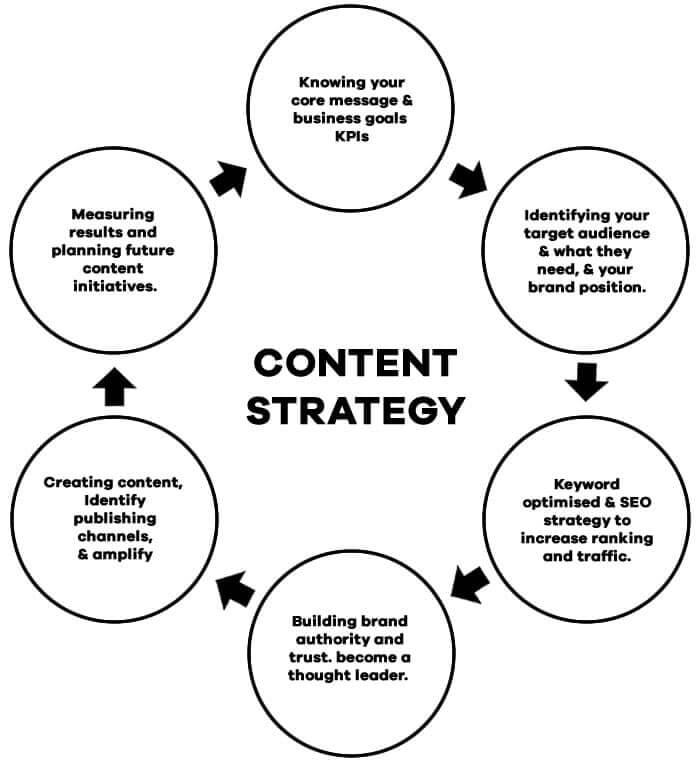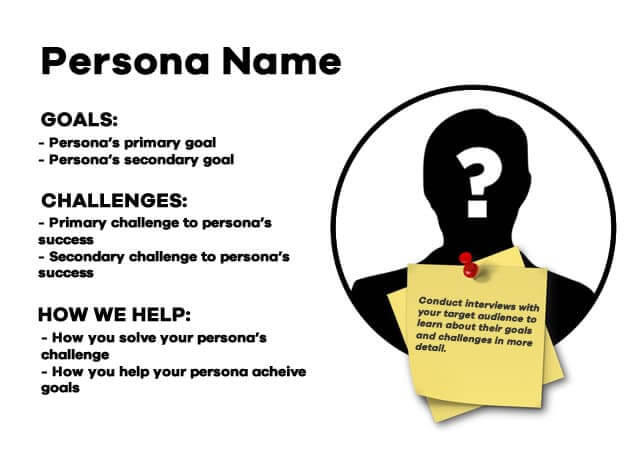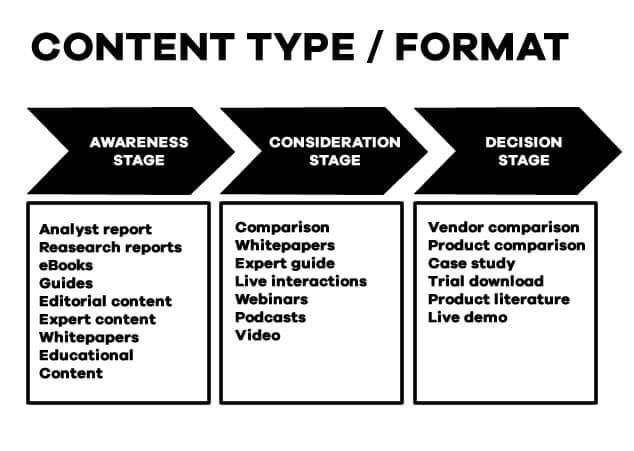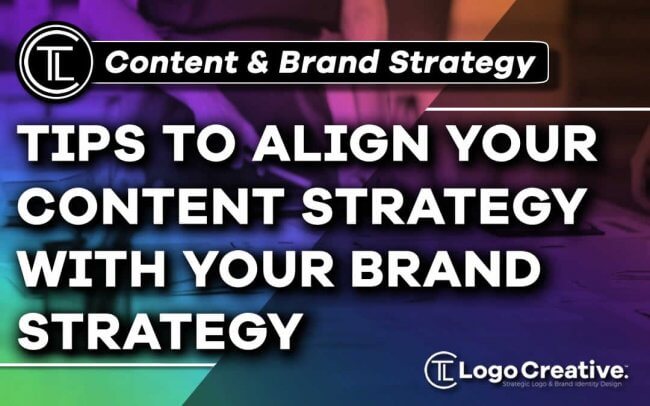Your brand is much more than just the name of your company, your logo, or your tagline. It encompasses the entire experience your prospects and your customers have when interacting with you. In this article we share 6 Tips to Align Your Content Strategy With Your Brand Strategy.
Your logo, colour palette, tone and personality are important, but these are elements used to convey the brand’s message and do not make up the brand itself.
Your brand is perceived by your target audience in many ways:
- Messages conveyed by your website and campaigns
- Quality of interaction(s) between you and your customers
- Customer’s opinion of you as compared to your competitors
- Image(s) evoked by the name of your business
How can you ensure that you create the right image in the minds of your customers?
You devise a well-thought-out brand strategy that defines who you are, who you’re here for and how you intend to send that message to your audience.
One of the ways in which you can communicate targeted messages about your brand is through a landing page, a dedicated page distinct from your website homepage that promises visitors a benefit, usually in exchange for contact information.
Interested visitors can be directed from your landing page to your website if they want more information. You can also solicit names and email addresses in return for free assets to create a database of leads.
A landing page builder helps you create a professional landing page that delivers on its promise and boosts conversions by incorporating the right trust elements. Thus, you can attract the right kind of visitors to enable you to achieve the outcomes you want.
After all, a brand is what your customers think, feel and say about your business and not just what you tell them about yourself.
Table of Contents
Brand Strategy is Not the Same as Content Strategy

Brand strategy is often mistaken to be the same as content strategy, and that’s why many content marketing strategies fail to have the desired effect.
Content strategy is a part of brand strategy. It is shaped and defined by the brand strategy.
Let’s understand the differences between brand strategy and content strategy and see how they are connected.
Brand strategy
Your brand strategy is a long-term strategic plan to establish your value and authenticity among your target audience.
Brand strategy work takes the following factors into account:
- Brand positioning – How can you occupy a distinctive position in the minds of your customers? Who are your buyer personas?
- Brand story – How can you use storytelling to articulate the most powerful things about your business?
- Brand values – What specific values do you want your business to be known for?
- Brand personality – What human characteristics would you attribute to your brand to help your customers relate to you? How will you increase your brand equity?
- Brand promise – What is the promise that you’re making to your customers and what sort of experience do you guarantee them?
- Brand messaging – How do you articulate your brand values, unique selling propositions and benefits to your customers? What is your content marketing strategy to achieve your business goals?
Thus, you can see how a content marketing strategy (that includes your content strategy) fits into a brand strategy.
Content Marketing Strategy
Your content marketing strategy is the vehicle you use to execute your brand strategy–through content–to get the business outcomes you want, such as generating leads, increasing brand awareness, raising engagement or supporting sales enablement.
Guided by your brand strategy, your content marketing strategy covers everything you will use to connect with your audience and convey your message.
This includes content goals and definitions, measurement metrics, lead mapping, buyer personas, keyword strategy, channel opportunities, editorial calendar, media planning and budget allocation.

Content strategy is a map that guides the content marketing strategy. It answers ‘why’ you’re publishing content–to what end?
The important elements of a content strategy are:
- Major themes
- Purpose of content
- Content gap analysis
- Search engine optimization
- Content attribution frameworks
The goal of your content strategy should be to make a genuine connection with your target audience and solve their problems. It builds the foundation for long-term trust with customers and overall goodwill.
Hence, your content strategy should work hand-in-hand with your brand strategy. Together, they strengthen and grow your brand.
Case study: How Superdrug Achieved a 238% Increase in Organic Search traffic

Superdrug, a UK retailer of health and beauty products, wanted to raise awareness around body image issues and unrealistic beauty standards.
They launched a campaign called ‘Perceptions of Perfection’ wherein designers from 18 countries were asked to retouch an image to fit in with their perceptions of beauty.
As part of the content strategy, a visual asset with a compilation of the retouched images was created.
The campaign achieved the following outcomes:
- More than 700,000 page views from the Superdrug website
- 238% increase in organic search traffic over 16 months
- Approximately 1,000,000 shares on social media
- Picked up by 600 well-known publishers like The New York Times, CNN and Buzzfeed
- Celebrity mentions by the likes of Lil Wayne and Sofia Vergara
You’ve seen how powerful a targeted content strategy can be.
Now, let’s understand how to ensure that your content strategy and your brand strategy work together.
Align Your Content Strategy With Your Brand Strategy
A misaligned content strategy prevents you from working efficiently or effectively. Conflicting messages dilute brand value and harm the perception of your brand.
Here are a few tips to help you align your content strategy with your brand strategy:
1. Document Your Content Strategy Clearly
Without a clear and well-founded brand strategy, you’re simply running around in circles.
Document your core purpose, values, vision and mission before you start so that everyone is aware of what other teams/departments are doing.
With this as a guide, answer the following questions to define your content strategy:
- What are your content goals?
- What is the purpose of your content?
- Which messages do you want to prioritize?
- What audience needs are you addressing?
- How will you measure results or outcomes?
Your content ideas should align with your core identity and not just be based on what’s currently trending. Campaigns with a message that is relevant to your brand image will resonate with your audience.
2. Use Brand Stories
Stories can elicit powerful emotions much better than data. Brand stories that support your core values can sway customers in your favor.
“A brand is the set of expectations, memories, stories and relationships that, taken together, account for a consumer’s decision to choose one product or service over another.” Seth Godin
Brand stories compel customers to empathize with you and ultimately, develop a trusting relationship. They should support your positioning, value proposition, and tagline(s).
Brand stories are flexible enough to be adapted to your target audience and content distribution channels.
When developing content ideas, ensure that they reflect your brand stories.
3. Test Ideas Against Your Buyer Personas
Your brand goals may not always align with audience needs. To find a connection, use your marketing personas (that should be a part of your brand strategy) to vet all your content ideas.
Ask yourself these questions:
- Does the content idea help to solve the persona’s problem?
- Does the idea deal with issues unique to the persona?
- Is this content idea educational, interesting or entertaining for the persona?

The beauty of this approach is that you can create new personas to test your content ideas against when you have new initiatives to launch or new channels to explore.
If you can find the right fit between your content ideas and the needs of your personas, you will find success in engaging their attention and eventually converting them into customers.
4. Align Your Content to Your Core Values
All forms of content you put out should tie in with your core values — vision, mission, and value proposition.
People want to support brands they find relatable. You need to stay true to your core identity to avoid confusing your prospects and customers.
Ensure that your content supports prospects at every stage of the buyer’s journey – awareness, consideration and decision making. Most B2B purchases begin with an online search, so you should adapt your content strategy to meet customer information needs at every step of the way.

The goal of your content should be to strike a chord with your target audience and persuade them to care for you, not to go viral.
Tactics like newsjacking, wherein a brand aligns itself with a trending piece of news to gain more eyeballs, can backfire and leave a negative impression on people. Or it may fail to have any impact at all because it has no connection with your brand values.
User experience also matters, which includes elements like the design and user-friendliness of your website and apps.
5. Follow Brand Guidelines
Brand guidelines help to maintain brand integrity and on-brand messaging for each piece of content. It is especially important when you’re creating a large volume of content or you’re working with many content creators.
A comprehensive brand style guide ensures that your messaging is cohesive and of uniform quality. Some of its important components are:
- Brand purpose, vision, mission, values
- Brand essence – voice, tone, personality
- Messaging – Tagline, differentiators, value proposition
- Visual identity – logo, colour palette, fonts
6. Assign a Brand Steward
Brand stewardship ensures healthy long-term growth of your brand by maintaining content integrity.
It is a methodology to keep track of all the moving parts of a content strategy and ensure that marketing messages meet brand guidelines.
The job of a brand steward (maybe an individual or a small group) is to keep the brand guidelines updated, perform quality assurance activities, and provide feedback to content creators.
Final thoughts
When the differences between brand strategy and content strategy are understood, everyone works in alignment with the overall goals of the brand. It presents a cohesive and consistent image to customers.
Thus, a focused content strategy that is informed by brand strategy helps you build trust and establish expertise.
Join The Logo Community
We hope you enjoyed these 6 Tips to Align Your Content Strategy With Your Brand Strategy.
If you would like more personal tips, advice, insights, and access to our community threads and other goodies, join us in our community.
You can comment directly on posts, access our community threads, have a discussion and ask questions with our founder Andrew.
If you’re looking to learn more about brand strategy, we highly recommend eRESONAID with our friend and acclaimed brand strategist and author Fabian Geyrhalter, it’s packed full of knowledge and insights you will need to learn to become a brand strategist or apply what you learn within your own business.
Author Bio
Lucy Manole is a creative content writer and strategist at Marketing Digest. She specializes in writing about digital marketing, technology, entrepreneurship, and education. When she is not writing or editing, she spends time reading books, cooking and traveling.


